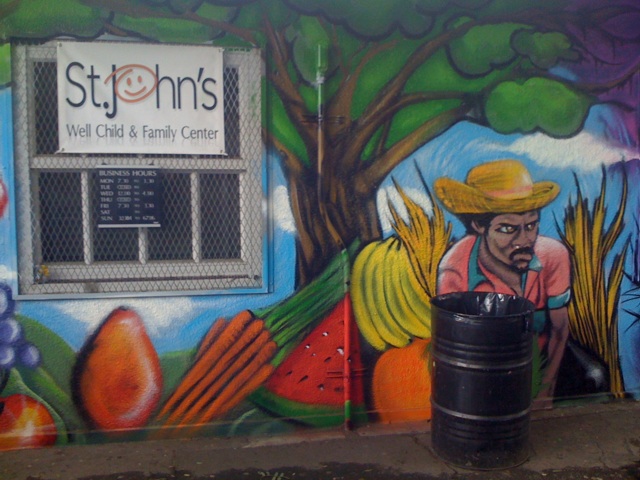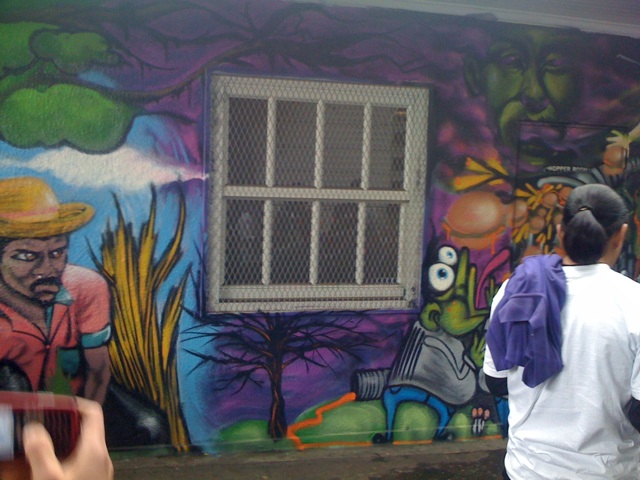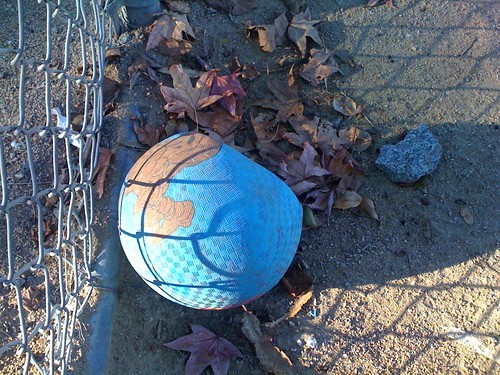A student asked me to put these photos up – my third period is writing an essay analyzing the narrative and intent behind a recent mural on campus.





A student asked me to put these photos up – my third period is writing an essay analyzing the narrative and intent behind a recent mural on campus.






The table is a civilizing place. It’s where a group comes and they hear points of view, they learn about courtesy and kindness, they learn about what it is to live in a community – live in a family first, but live in bigger community. That’s where it comes from, don’t you think?
And
And I just feel like the best way to inflence those kids is to help educate them in the public school system and to teach them to open their senses. Do you know that eighty-five percent of kids in this country don’t eat one meal with their family a day? I think we just forgot, you know. It just got thrown out that idea of being around a table. And we don’t know what got thrown out with it. There are a lot of things that happen around a table; even if you don’t like what’s on the table and you can’t communicate with your family, you have to sit there in a way and wait ’til that guy stops talking so that you go pass the bread to another or use a napkin or a fork or a knife. And those things are becoming very foreign to a lot of children! It’s an offering to-someone-who-needs-food. It’s healing. And I think that’s what the table is! It’s an offering to nourish people! And the more you’re out there, the more you realize what’s upstream is coming downstream. The more you realize that, you know, we’re all sort of connected here.
From this play, incidentally. (Will be reading with the eleventh graders in two weeks.)
We discussed this article in my classes today – didn’t get the copies until this morning, otherwise it would have been yesterday. The move away from single narratives and the critique of “change” and “revolution” fits nicely with the texts in all three of my classes: Song of Solomon, Zoot Suit, and Savage Inequalities.

The last few days before break, Peter* – the tenth grade English teacher & senior Homeroom teacher in our SLC – spent time after school engaged in leading dance lessons. His vision: have all of the seniors of the School of Communication and Global Awareness waltz at their prom in five months’ time.
Starting small, a handful of students stayed after school days before their holiday break. Some happened to be engaged in board games, unknowingly witnessing the transformation of the classroom into a workable dance studio; the tables were folded away and the game players ushered to the walls, creating a sizable space for movement.
A half dozen of us then began the lessons of waltzing. Armed with only a single piano track and Elliott Smith’s “Waltz #2,” we patiently learned the give and take of the ¾ routine. There’s still plenty of work to be done.
What intrigued me most were the conversations that sprang forth – explanation of the typical male and female/lead and follow roles in dance lead to discussions of feminism that had already been well underway from reading The Awakening in my class throughout December. Likewise, the waltz lead to a lengthy exchange of cultural dances and a rushing forth to YouTube for songs students connected with, wanted to share, and felt worth explicating the importance of. I followed suit and shared my fascination with (and utter clumsiness at pulling off) Crip Walking. This too lead to discussions of power and representation and ownership of dances and culture.
Occasionally, students would walk past the door and peer in: Elliott Smith crooning through one set of speakers, a pair of students teaching left-footed teachers to salsa, and Elton John’s “Crocodile Rock” blaring distortedly through laptop speakers. It was the kind of organized chaos that only comes from multilateral engagement.
And what if such practices became the centerpiece not simply in elective courses but in the core – standardized tested – classes? If the history and power dynamics of dance became the center of social studies? If we read the language and analyze the suggestions of performance and aesthetic? And what about Sousaphones? Once we’d gotten past the awkwardness of uninhibited movement, we were all engaged in understanding and in learning; in the three post-finals days at Manual Arts – a time that finds teachers finalizing grades and generally showing films and letting students hang out – this was the most engaged I’d seen students.
*As with many of the friends I work with regularly, I’ve mentioned Peter several times on this blog. His comment to this prior post is especially worth a look.
I’ve been thinking about the viral videos that stuck with me over the year. They’ve become less of surprised hamsters and klutzy candid camera mishaps and adorable kittens doing crazy things. Instead, the videos I typically find myself drawn into are the videos of pastiche, remix, and co-authorship.*
Underground MC, Nyle, for instance took an already catchy Kanye produced hook and built it into something arguably better than the original.
Likewise, as much as “I’ve Gotta Feeling” was the inescapable single for much of the year, a bunch of Canadian students somehow made it more personal and exuberant than its overuse in sporting events and capitalist merchandising ever could have.
Why do these things matter? First of all, both are the kinds of videos that – with a bit of creative ingenuity – would be easy for students to create in the classroom. They’re the way students should be interacting with their media at this point. Researchers keep pointing to the way authorship is changing and the fact that students are producers of media. This isn’t something new. However, at least in the context of an urban secondary school, such work of young producers isn’t exactly being encouraged. Think of the empowering potential of having student work go “viral.”
Earlier this year, it felt like a thrill to facilitate a couple of professional development seminars at my school in which I go to talk about the academic validity of Soulja Boy’s dance for “Tell ‘Em.” It was silly but illuminating. 2010 seems like the year for our students to remix the cultural artifacts around them and start making them their own.
* Thinking more broadly about teaching the way to share these kinds of materials, I realize a bit of theory is going to need to inform our class work. I’m working my way through the latest collection of Gladwell’s New Yorker articles and felt that this article on copyright and plagiarism is especially useful; it’s also a great gateway into discussions of Creative Commons and Lessig’s work.
The current issue of XChange, published online by UCLA’s Center X is focused around “Media & Techno Literacies.” There are some tremendous resources up there for current teachers as well as plenty of readings to peruse.
The “Rethinking MySpace” article I wrote a while ago can be found here along with a brief introduction about changes to the social networking landscape since the article’s initial publication.
Likewise, a podcasting unit I implemented called “Voices of Struggle” can be found as part of XChange here. Though I’m happy to work with teachers adapting the unit, I’m mainly linking here to share the audio samples two of my former students created.
Thanks, Jeff Share, for including me in the issue.

While my teacher email lists were abuzz with the fact that Fremont High School is being reconstituted, the LA Times ran a more positive spin on education reform in the city and it focused on Manual Arts. I asked my students to respond to the article after we discussed it in class. The general consensus was that Sandy Banks’ perception of the school did not match that of our students. I typed up a smattering of student responses to share with Mike and the MLA staff that you are welcome to read below. Personally, I think there’s tremendous merit in the work behind the Doolittle mural project and the school’s garden. However, I was surprised by the vitriol my students had for these efforts – the fact that emphasis in the column was placed on seemingly cosmetic changes rather than on changes that directly impact student achievement. I do think that students used this as an opportunity to voice concern about the school as a whole – not necessarily what MLA is presently doing. And, at the end of the day, I think that’s pretty reasonable; should students really have to care who is taking care of the barriers to their learning? The fact that they exist should be enough for them to don a tone of vexation. Aside from some spelling corrections, student responses are unedited below.
Sandy Banks’ column on improvement in Manual Arts High School could not have been more wrong and infuriating. As a student from said school, I couldn’t help but laugh at all the emphasis put on Manual Arts’ “positives;” all seven of them. I find it to be like a joke in poor taste. We have a little garden and a couple of people being paid to keep freshman from dropping out, but compared to everything else about Manual Arts, those things are barely anything but trivial. The truth about Manual Arts and all other schools like it is that it’s negative qualities outweigh any positives. If anything, Banks should have written about how Manual Arts needs improvement. By building up that little shit garden or not quite mentioning drop-out rates or other failures, we are giving those in charge of taking care of the school the chance to just walk away. I don’t like the idea of our help walking away thinking we don’t need anything because we’re growing vegetables behind some crappy building!
At Manual Arts, the change is successful when MLA came. First they gave money to clubs to make a difference. As a member of the Science Club, MLA gave money to my sponsor to make a garden. We made a garden that I thought was for everybody in the community. But the garden is not even open for everybody. I feel like MLA is changing the school but not helping students to enjoy a beautiful garden. Even though I helped make the garden I don’t have access to go inside it. Also, the article talks about money that every student gets. As a senior, I haven’t seen any of the money go to my education. I see the same old computers in the same classrooms that are really old. MLA is just making MAHS look good but not changing how students feel about it or how we are being educated.
I believe that this school should be reconstituted like Fremont.
Call it naïve optimism, but I didnt think that my UTLA shirt saying “A War Budget Leaves Every Child Behind” would still be so relevant as we turn the corner into the year 2010. In terms of nationwide, statewide, and citywide policy and legislation, its clear that our students and our community here at Manual Arts continue to be the last concern.
Tomorrow, I will march with my union sisters and brothers because daily I am humbled by the efforts our community goes through to provide the best we can with the little we have. I will march and yell and oppose because our students are being silenced in political life. Each student that is placed in a class that’s too big with outdated materials or drops out or doesnt pass the CAHSEE is another incident of our government and LAUSD and our school board turning their backs on those that have been ignored for too long.
Im honored to march on Beaudry with such an amazing community of educators. I look forward to seeing you there.
Antero Garcia
I fear that maybe in thinking about counter-narratives and the role of storytelling, I’ve been thinking too small. Maybe we need to start with a macro-vision of life in the classroom.
What would it look like for students to develop their own creation myths? In disrupting the “single story” of their neighborhoods and various cycles and pipelines that scholars say move our students around on a vast conveyer belt, perhaps it’s about having students reinvent the entire foundation from the ground up.
Travis, my SLC’s 9th grade English teacher shared with me the success he had in getting his class back on track through an introduction of mythology. Peter, our 10th grade teacher, will be starting Ishmael with his students later this year (a book also about creation myths). As my 12th graders delve into The Awakening, I borrowed a suggestion that Mark made for a different class, and showed my students this TED talk about the problems of the “Single Story;” it seemed most appropriate as a way of connecting Achebe, Conrad, and Chopin within the past month. I think also of Daye’s interest in Cargo Cults and the way they may act as a metaphor for deception in South Central.
I think the students would be properly situated in a foundation of already studied (as well as lived & experienced) creation myths. How about now reinventing them?

Related to the Google image search lesson mentioned in this post, my student today shared an activity he did over his break.
Passing the time during the thanksgiving break, Cristian typed into Google image search “Beverly Hills.” He said he noticed all of the clean streets and smiling white people. Next, he typed into Google image search “South Central Los Angeles.” The contrast is striking: power lines, fast food, gangs, police making arrests.
As a class, we discussed what stories are being told about these communities. What is being left out and why? As we continue to explore the dual cities in Los Angeles, how we’re able to re-mold the story being told will continue to be the charge our class will take up.
Thanks for sharing the lesson, Cristian.